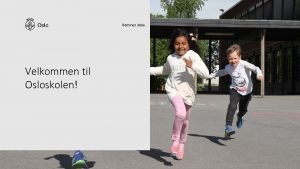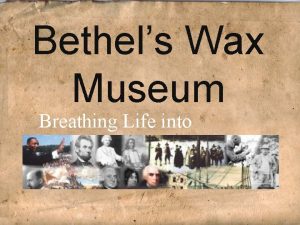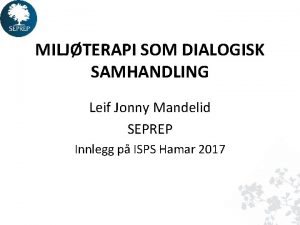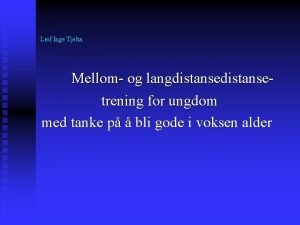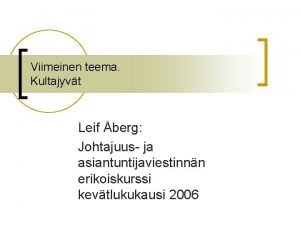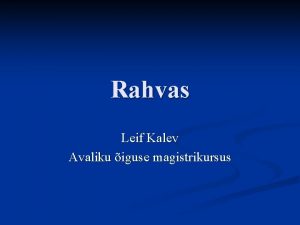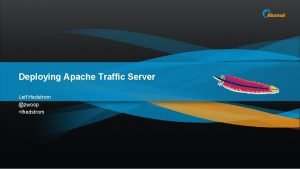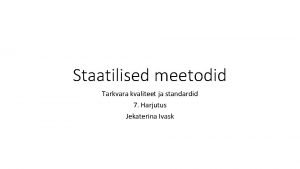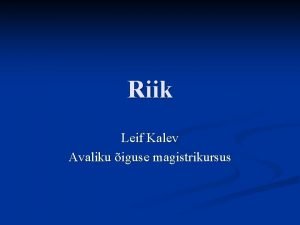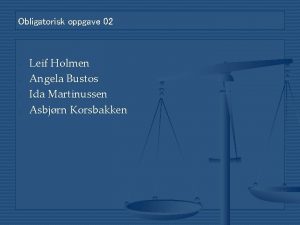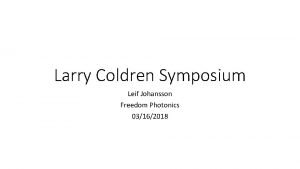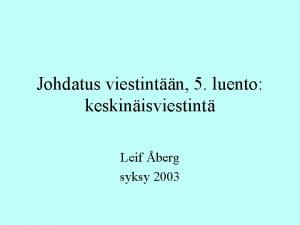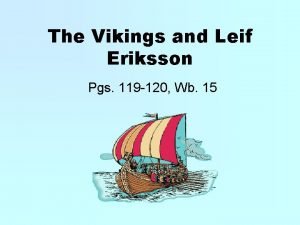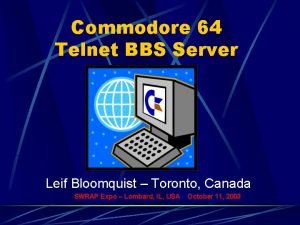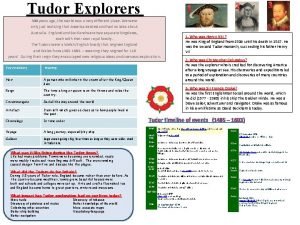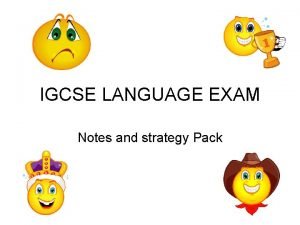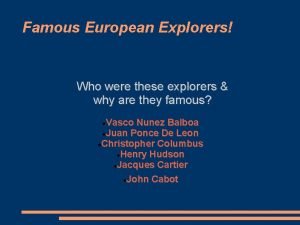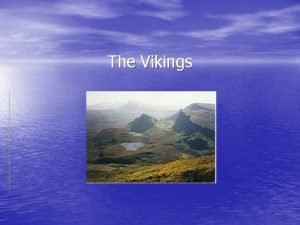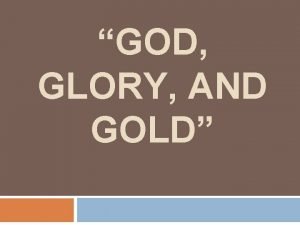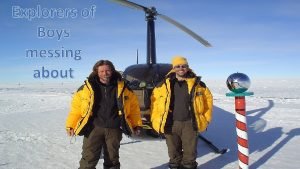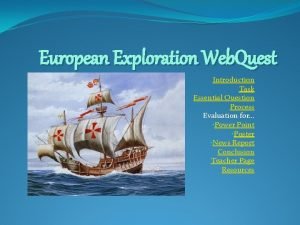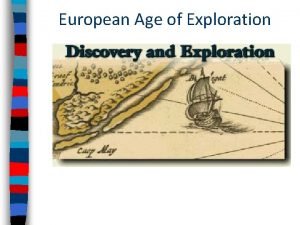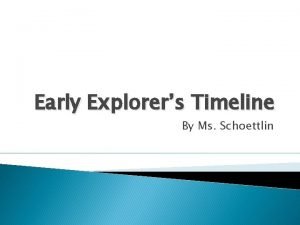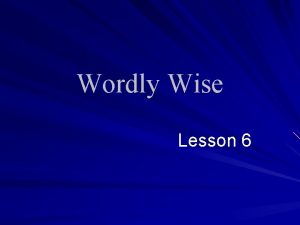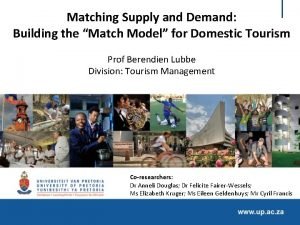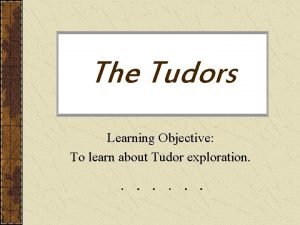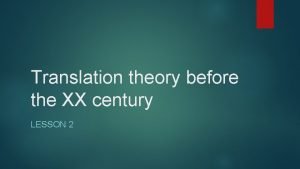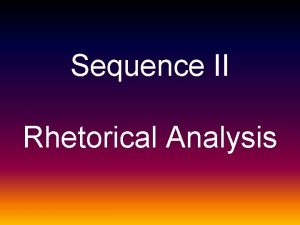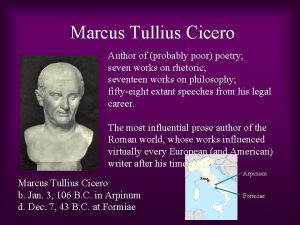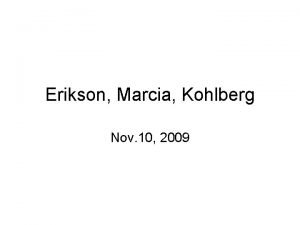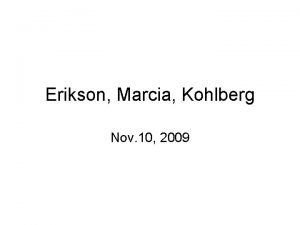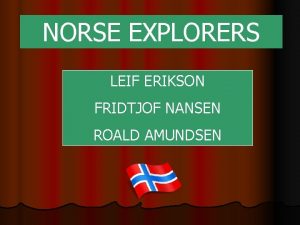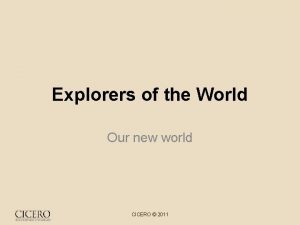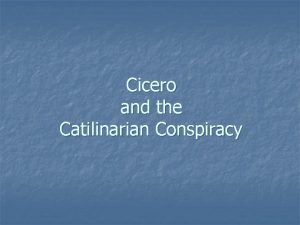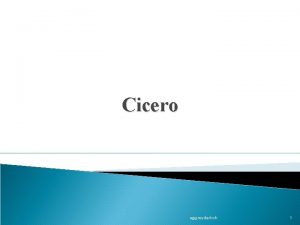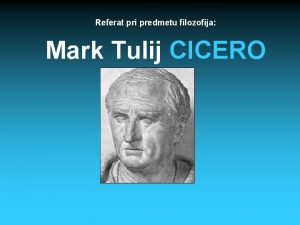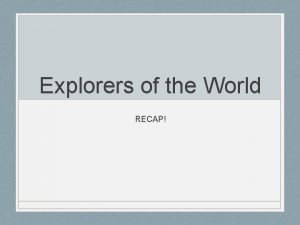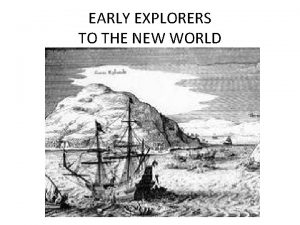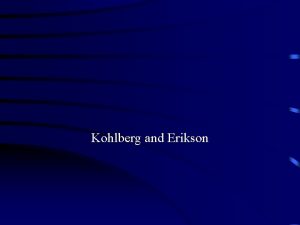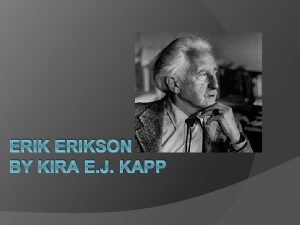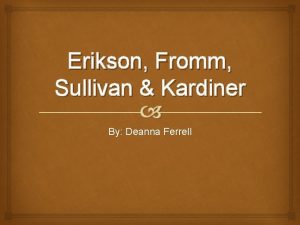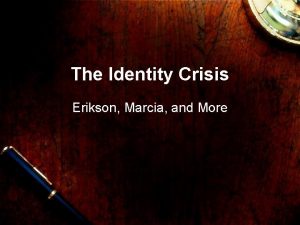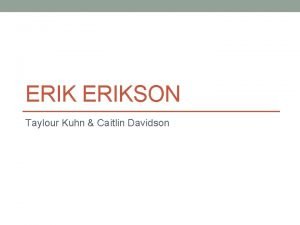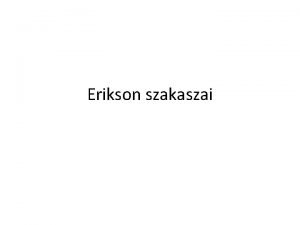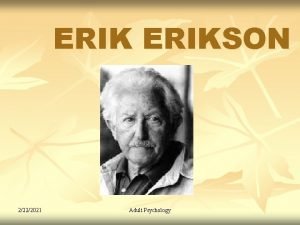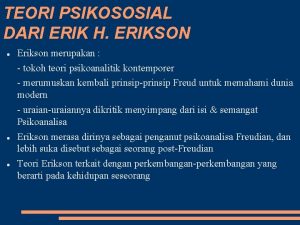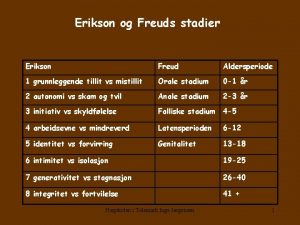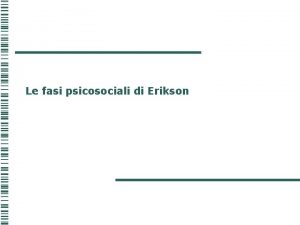Explorers of the World CICERO 2011 Leif Erikson
































- Slides: 32

Explorers of the World CICERO © 2011

Leif Erikson circa 970 – 1020 A. D. • Leif Ericson was the son of Eric the Red, leader of Viking colony in Greenland. • Sometime around 1000 A. D. , Erikson sailed to the east coast of North America with a crew of about 35 men. • Recent archeological evidence suggests that they may have traveled as far south as Maine or Massachusetts. CICERO © 2011 This U. S. postage stamp was issued on October 9, 1968, to commemorate Leif Ericson Day.

Marco Polo circa 1254 – 1324 A. D. • As a teenager, Marco Polo traveled the Silk Road with his father and uncle. • Around 1274, they reached the court of Kublai Khan in present-day Beijing China. • Polo traveled Asia for about 25 years before returning to Venice. • His adventures were published in The Travels of Marco Polo. • His stories of the East inspired future European explorers including Christopher Columbus and Vasco da Gama. CICERO © 2011 According to legend, Polo introduced pasta to Italy.

Prince Henry the Navigator 1394 – 1460 A. D. • Beginning around 1420, Prince Henry of Portugal financed several voyages to – map the western coast of Africa; – establish trade with other kingdoms; – spread the Christian faith; – find an all-water route to Asia and the Far East. • As a result of these voyages, – Portugal seized the Azores, Madeira, and Cape Verde islands and began growing sugarcane there; – they brought African slaves to the islands to work in the fields; – this was the beginning of what would become the Atlantic Slave Trade. CICERO © 2011 In 1419, Prince Henry set up a school and research center for navigation, cartography (mapmaking), and astronomy.

Bartolomeu Dias circa 1450 – 1500 A. D. • In the summer of 1487, this navigator set sail from Portugal down the west coast of Africa. • After surviving stormy seas, he decided to turn back. • It was on his return trip that he realized they had reached the southern tip of Africa. • Dias wanted to continue, but his crew refused and by December of 1488, they were back in Lisbon. • This voyage paved the way for future expeditions to Asia. CICERO © 2011 Dias named the cape at the southern tip of Africa the “Cape of Storms. ” King John II of Portugal renamed it the “Cape of Good Hope. ”

Christopher Columbus 1451 – 1506 A. D. • This Italian explorer began sailing in his early teens. • Using his knowledge of ocean currents and wind patterns, he developed a radical new theory: –He believed he could reach Asia by sailing west from the Canary Islands. • He first tried to sell his idea to Portugal, but the king was not interested. • After nearly a decade, he convinced the king and queen of Spain to finance his voyage. CICERO © 2011

Christopher Columbus • With 3 ships and a crew of 89 men, Columbus left Spain on August 3, 1492. • On October 12, the fleet came ashore on an island in the Bahamas. • They explored several more islands before returning to Spain. • Hailed as a hero, Columbus easily received financing for a much larger second voyage. • In all, Columbus led four voyages to the “New World. ” CICERO © 2011 Columbus referred to the native Taino people as “Indians” because he thought he had reached the East Indes. He brought six of these natives back to Spain.

John Cabot circa 1451 – 1499 A. D. • In 1497, this Italian sailor led the first attempt to find a Northwest Passage to Asia. • Financed by King Henry VII of England, the expedition sailed from Bristol in the Matthew and landed in Newfoundland in June. – They were the first Europeans since the Vikings to set foot in North America. • While Cabot never found the Northwest Passage, the knowledge he brought back propelled England into a fierce competition with Spain. CICERO © 2011 In May 1498, Cabot and 300 crewmembers sailed from Bristol on a second voyage, but they were never heard from again.

Vasco da Gama circa 1460 – 1524 A. D. • In 1497, this Portuguese explorer followed the route mapped by Bartolomeu Dias a decade earlier. • In 1498, da Gama became the first European to reach the Indian Ocean by sailing around the southern tip of Africa. • On May 20, the fleet landed at the port of Calicut, India. • When they returned to Portugal in 1499, da Gama was appointed “Admiral of the Indian Seas. ” CICERO © 2011

Pedro Álvares Cabral circa 1467 – 1520 A. D. • On March 9, 1500, Cabral set sail from Lisbon with 13 ships on an expedition to India. • On April 22, the crew sighted land that was initially thought to be an island. • Cabral came ashore, claimed the land for Portugal, and named it Island of Vera Cruz. • It was later discovered that this “island” was actually the coast of a continent and it was renamed Brazil*. CICERO © 2011 Cabral spent 10 days in Brazil before heading toward the Cape of Good Hope where violent storms wrecked 4 of the ships on this voyage. Bartolomeu Dias was among those killed.

Amerigo Vespucci • In 1501, this Italian explorer was invited to join a Portuguese expedition to Brazil. • He mapped the coastline of South America and explored the Amazon River. • He may have been the first to suggest that Europeans had not reached Asia, but an new continent. • German mapmakers were so impressed by his detailed maps that they named the new continent in his honor. CICERO © 2011 Born in Florence, Amerigo Vespucci once worked for Lorenzo di Medici.

Waldseemüller World Map CICERO © 2011

Juan Ponce de Leon circa 1460 – 1521 A. D. • This Spanish soldier traveled to the New World in hopes of making his fortune. • De Leon served as the first governor of Puerto Rico. • However, a political struggle between de Leon and Diego Colon (Columbus’ son) ended with de Leon losing his position. • In search of gold and determined to restore his reputation, de Leon left San Juan to explore the islands north of Cuba. CICERO © 2011 Juan Ponce de Leon was well known for his bravery in battle during the final years of the Spanish Reconquista – the war to drive the Muslims from Spain.

Juan Ponce de Leon • In the spring of 1513, de Leon reached land which he named “La Florida. ” • According to popular belief, de Leon discovered Florida while searching for the “Fountain of Youth. ” • However, many modern scholars note that his name was not associated with the legendary fountain until after his death. CICERO © 2011

Vasco Nunez de Balboa 1475 – 1519 A. D. • This Spanish explorer traveled throughout Central America. • In 1513, he was the first European to reach the western ocean, which he named the “South Sea. ” • Balboa traveled with a pack of War Dogs (as did most Spanish conquistadors). • Bartolome de Las Casas later described gruesome scenes in which these dogs were “unleashed” on the Indians. CICERO © 2011

Hernando Cortez 1485 – 1547 A. D. • In 1519, this Spanish conquistador landed on the east coast of Mexico with 11 ships, 550 men, and 16 horses. • Cortez claimed the land for the Spanish and began to explore. • Along the way, Cortez and his men met several Indian tribes: – Having never seen horses before, these natives feared the white men and their beasts. – However, they also feared the Aztecs, who controlled the entire area. CICERO © 2011 Many of the natives Cortez met became willing allies against the Aztecs, who often raided neighboring villages and sacrificed captives to please Aztec gods.

Hernando Cortez • In November, Cortez entered the Aztec capital, Tenochtitlan, with as many as 5, 000 native allies. • This magnificent city was filled with gold, silver, and other riches. • By the summer of 1521 the once mighty Aztec Empire had fallen. • Far more deadly than their weapons, European disease played a major role in this and later European conquests throughout the Americas. The Aztecs suffered a devastating epidemic of Small Pox just weeks before the conquest. CICERO © 2011

Ferdinand Magellan 1480 – 1521 A. D. • In 1519, Spain financed the voyage of this Portuguese explorer. • Magellan’s goal was to reach the Spice Islands of southeast Asia by sailing west, through the Americas, and into Balboa’s South Sea. • On September 20, he set sail with five ships and a crew of 250 men. • From the beginning, the expedition was fraught with disaster. CICERO © 2011

Ferdinand Magellan • In November of 1520, only 3 ships entered the South Sea, which Magellan reamed “Pacific. ” • Nearly one year later, only two ships made it to the Spice Islands. • On September 6, 1522, one ship with a crew of only 18 men returned to Spain. – They were the first Europeans to circumnavigate the globe. • Magellan did not complete the journey with his crew. – He was killed by natives before even reaching the Spice Islands. CICERO © 2011 Some say that the Mactan natives who killed Magellan ate his body.

Giovanni Verrazzano 1485 – 1528 A. D. • This Italian explorer received funding for his expeditions from King Francois I of France. • His goals were to – gather information about the eastern coast of the New World – locate a passageway from Europe to Asia through the Americas. • In January of 1524, Verrazzano set sail on La Dauphine • Although they did not find a passage to Asia, they were the first to explore the Atlantic coast from North Carolina to Maine. CICERO © 2011 Giovanni Verrazzano’s younger brother Girolamo, accompanied him on his voyages as the cartographer.

Francisco Pizarro circa 1475 - 1541 • This Spanish conquistador travelled along the Pacific coast of South America with a group of about 180 soldiers. • They arrived in the Incan Empire in modern day Peru around 1532. • Upon arrival, they arranged a meeting with the Incan emperor, Atahualpa (ah-tah-WAHL-pah). • Pizarro and his men abducted the emperor and held him for ransom. CICERO © 2011

Francisco Pizarro • Although the Incas paid the ransom, the Spaniards murdered Atahualpa. • Pizarro and his men marched to the Incan capital of Cuzco. • By 1535, the Spanish conquest of the Inca was complete and Pizarro founded the city of Lima. • Pizarro was later assassinated by followers of Diego de Almagro, who had been Pizarro’s partner in the conquest of the Inca. CICERO © 2011

Jacques Cartier 1491 – 1557 A. D. • This French explorer led 3 voyages to Canada in search of the Northwest Passage. • In 1535, Cartier discovered the St. Lawrence River, which he (mistakenly) believed to be the Northwest Passage. • Although he never found the elusive passage to Asia, Cartier’s expeditions opened North America to further French exploration and settlement. CICERO © 2011

Hernando de Soto circa 1496 – 1542 A. D. • This conquistador may have seen more of the Americas than any other European of his day. • In 1523, he explored Nicaragua and Honduras with Francisco de Córdoba. • In 1532, he helped Pizarro conquer the Inca in Peru. • May 30, 1539, de Soto landed at present-day Tampa Bay, Florida. • De Soto and his men embarked on a 3 -year trek from Florida to the Mississippi River. CICERO © 2011

Francisco de Coronado 1510 – 1554 A. D. • This Spanish explorer was the governor of a Mexican province when he led an expedition into what is now the American southwest. • In 1540, Coronado set out in search of the mythical Seven Cities of Gold. • The expedition traveled north through parts of present-day Arizona, New Mexico, Texas, Oklahoma, and Kansas. • Failing to find cities of gold, Coronado returned to Mexico in 1542. CICERO © 2011

Juan Cabrillo circa 1500 – 1543 A. D. • This Portuguese explorer sailed in the service of Spain. • In 1542, he led the first European voyage up the coast of present-day California. • The expedition sailed as far north as present-day Oregon before an outbreak of scurvy forced them to return to Mexico. • During a brief stop for repairs, Cabrillo suffered an injury that became infected; he died on January 3, 1543. CICERO © 2011

Sir Francis Drake circa 1540 – 1596 A. D. • This British navigator, slave-trader, and privateer was a hero in England a villain in Spain. • Between 1577 and 1580, Drake became the second sea-captain to circumnavigate the globe; Along the way, Drake – raided Spanish ships and colonies – claimed a portion of present-day California for England • In 1588, Drake was second in command of the British fleet that defeated the Spanish Armada in the English Channel. CICERO © 2011 When he returned from his 1577 voyage, Queen Elizabeth I knighted Drake aboard his ship, the Golden Hind.

Samuel de Champlain 1567 – 1635 A. D. • This French explorer and cartographer is known as the “Father of New France. ” • In 1603, he mapped the Saint Lawrence River. • From 1604 to 1606, he explored and mapped the coast of North America from Canada to Cape Cod. • In 1608 he established a settlement at Quebec and discovered the lake that was named in his honor in 1609. CICERO © 2011 Samuel de Champlain published several accounts of his explorations. The Founding of Quebec is available from Ci. CERO Unit 3 Primary Sources.

Henry Hudson • This English explorer led several voyages in search of the Northwest Passage. • His first 2 voyages (1607 and 1608) were funded by a British company. – Icy conditions near the Arctic Circle forced Hudson to turn back both times. • His 3 rd voyage (1609), was funded by the Dutch East India Company (a rival of England) – Hudson explored the river named in his honor as far as present-day Albany. CICERO © 2011

Henry Hudson • In 1610, Hudson again sailed for 2 British companies (the Virginia Company and the British East India Company) • This expedition entered the strait and bay later named in Hudson’s honor. • After a harsh winter, he tried to force his crew to continue exploring. • Instead, they mutinied and left Hudson floating in a small boat on Hudson’s Bay. CICERO © 2011 Henry Hudson and the members his crew that were left marooned at Hudson’s Bay were immortalized in Washington Irving’s classic tale, Rip Van Winkle.

Marquette and Joliet • In 1673, Marquette and Joliet set out with 5 others and 2 canoes – to set up Christian missions among the Indians – to establish trading posts with the Indians for the French – to investigate rumors of a large river (the Mississippi) which was thought to connect to the Pacific Ocean. • They explored the Mississippi all the way to the mouth of the Arkansas River. • Early on, they met the Illinois Indians, whose chief sent his son with them as a guide. CICERO © 2011 Father Jacques Marquette, a Jesuit Priest, and French Canadian explorer Louis Joliet are often presented in history as a team, since their most notable achievement was a journey they undertook together.

Robert La Salle • In 1682, this French explorer traveled the entire length of the Mississippi River. • La Salle claimed the entire Mississippi basin for France. • He named the area La Louisiane in honor of the French king, Louis XIV. • The French held the territory until 1803, when American diplomats negotiated an amazing deal – The Louisiana Purchase doubled the size of the U. S. for the bargain price of about 3 cents an acre! CICERO © 2011
 Where was leif erikson born
Where was leif erikson born Leif arild haaland
Leif arild haaland Jacob sedillo
Jacob sedillo Leif berg
Leif berg Leif jonny mandelid
Leif jonny mandelid Leif inge tjelta
Leif inge tjelta Leif brenne
Leif brenne Leif berg
Leif berg Leif kalev
Leif kalev Leif hedstrom
Leif hedstrom Leif kalev
Leif kalev Leif kalev
Leif kalev Leif holmen
Leif holmen Freedom photonics
Freedom photonics Leif berg
Leif berg Vikings eriksson
Vikings eriksson Bbs server software
Bbs server software Tudor explorers
Tudor explorers Chinese cinderella igcse
Chinese cinderella igcse Famous european explorers
Famous european explorers Spontaneous budget explorers
Spontaneous budget explorers Vikings: merchants and explorers
Vikings: merchants and explorers Gold glory and god
Gold glory and god Jo vestey
Jo vestey Age of exploration webquest
Age of exploration webquest European explorers
European explorers Early explorers timeline
Early explorers timeline Explorers wordly wise
Explorers wordly wise Supply demand matching
Supply demand matching Tudor exploration
Tudor exploration Cicero translation theory
Cicero translation theory Rhetorical stance
Rhetorical stance Cicero poetry
Cicero poetry

